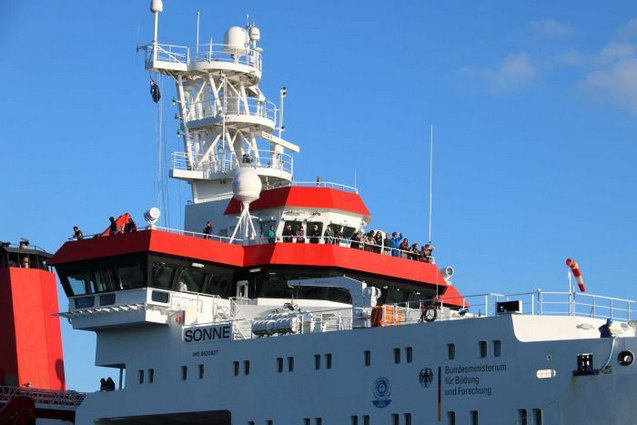 |
| The RV Sonne can deploy instruments into the deepest parts of the ocean. (ABC News: David Weber) |
A German research vessel has been taking samples from
the ocean floor in Australian waters to investigate the history of
climate change.
The ship, described as one of the most high-tech
research vessels in the world, is looking into the past to help predict
the future.RV Sonne is described as the most important platform for marine scientific research in the Indo-Pacific.
 |
| Captain Oliver Meyer said the RV Sonne's main role was to study the influence of humans on climate change. (ABC News: David Weber) |
"The big headline of all research is, more or less, the mankind influence of climate changes," he said.
"Are there interperiods of warm or hot climate or not, and what is the normal way that happens nature by nature or what is the mankind influence?"
RV Sonne has arrived in Fremantle after carrying out research around New Zealand, the outer side of the Great Barrier Reef and stopping in Darwin.
Its major benefit is to be able to operate in the deepest parts of the ocean, such as trenches in the "hadal zone".
RV Sonne's instruments retrieve sediments from the ocean floor, which acts as a kind of climate library.
 |
| Dozens of scientists can live and work on board the vessel during an expedition. (ABC News: David Weber) |
"Along the West Australian margin there was about 10,000 years ago a time when the climate was even a bit warmer than today and we want to see how this development, the influence of this relatively warm Southern Hemisphere period was on the Australian monsoon — and the climate," he said.
RV Sonne can deploy two pieces of gear at a time, instruments and devices such as its 'Golden Eye' — which measures electrical and magnetic properties of the sub-seabed — as well as remotely controlled underwater vehicles, drill rigs, and a mobile 3D seismometer.
 |
| The ship is equipped with cranes and other machinery to help carry out research. (ABC News: David Weber) |
On its Darwin-Fremantle leg, RV Sonne carried teams interested in the deep and the shallow.
The University of Melbourne's Stephen Gallagher explained that his team was interested in what shallow waters could tell us about the past.
"We can get stories about shoreline, when the sea level fell, where was the shoreline. Are there fossil cliffs? What can we see under the sea when the sea level changes?" Professor Gallagher said.
"The deep climate archive, the hundreds of thousands of years-long climate archive comes from the deep water and evidence of the shoreline, when the sea level fell 18,000 years ago comes from the shallow water."
 |
| The ship is renowned for its ability to deploy instruments to the deepest parts of the ocean. (ABC News: David Weber) |
The vessel is equipped with eight laboratories and they can be cooled to freezing when required.
Some 40 scientists can live and work on board during an expedition.
Construction of RV Sonne started in 2012 and it was put into service in 2014.
It replaced the original Sonne, a 1969 stern trawler which was converted to a research vessel in the late 1970s.
 |
| The RV Sonne will be open to the public at Fremantle Port's Victoria Quay on Monday. (ABC News: David Weber) |
Links
- Research ship on lap of Antarctica makes Hobart pit stop
- On board the 'super science ship' uncovering secrets of the deep
- The free market will teach Trump the error of his ways on climate
- How climate change is putting koalas at risk
- UN raises concerns over water quality goals on Great Barrier Reef
- 6 charts that show Trump is out of step with US thinking on climate change
- World pledges to save 'Mother Earth' despite Trump's climate accord snub
- What will happen when Antarctica's Larsen C ice shelf cracks?
- Trump likened to 'classroom bully' after climate deal withdrawal
- Buildings go green as cities protest Trump's Paris exit
- Could Trump's exit from the Paris deal actually be a win for the environment?
- US business can still lead world to lower carbon future despite Trump's Paris pull-out

No comments:
Post a Comment